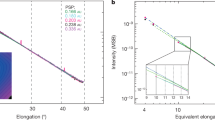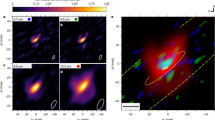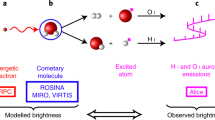Abstract
A near-infrared excess emission superposed on the coronal continuum at ∼4R⊙ from the Sun was first observed at 2.2 µm by Peterson1 and MacQueen2 during the total solar eclipse in 1966, and was later confirmed by MacQueen2 using a balloon-borne coronagraph. Two subsequent observations were made; one3 obtained a similar result, while the other4 detected no excess emission. The excess emission was thought to be due to thermal radiation by a dust cloud around the Sun, and interpreted to be interplanetary dust2. Brecher et al.5, on the other hand, have proposed that the ring is composed of much larger objects (of about 10 km diameter). To obtain more definite information, we have therefore carried out observations of near-infrared brightness distributions of the solar corona, using a balloon-borne photometer at a balloon altitude, during the total eclipse on 11 June 1983 in Indonesia. As we report here, emissions in excess of the strong coronal background emission were recorded in some of the scans at ∼4R⊙ from the Sun. The spatial distribution of the excess emission implies the existence of a circumsolar ring of dust lying approximately in the ecliptic plane.
This is a preview of subscription content, access via your institution
Access options
Subscribe to this journal
Receive 51 print issues and online access
$199.00 per year
only $3.90 per issue
Buy this article
- Purchase on Springer Link
- Instant access to full article PDF
Prices may be subject to local taxes which are calculated during checkout
Similar content being viewed by others
References
Peterson, A. W. Astrophys. J. Lett. 148, L37–L39 (1967).
MacQueen, R. M. Astrophys. J. 154, 1059–1076 (1968).
Peterson, A. W. Bull. Am. astr. Soc. 3, 500 (1971).
Rao, U. R. et al. Nature 289, 779–780 (1981).
Brecker, K., Brecker, A., Morrison, P. & Wasserman, I. Nature 282, 50–52 (1979).
Lamy, Ph. L. Astr. Astrophys. 33, 191–194 (1974).
Mukai, T. & Yamamoto, T. Publs astr. Soc. Japan 31, 585–595 (1979).
Weiss-Wrana, K. Astr. Astrophys. 126, 240–250 (1983).
Brownlee, D. E. in Cosmic Dust (ed. McDonnell, J. A. M.) 295–336 ( Wiley, New York, 1978).
Hashimoto, A., Kumazawa, M. & Onuma, N. Earth planet. Sci. Lett. 43, 13–21 (1979).
Röser, S. & Staude, H. J. Astr. Astrophys. 67, 381–394 (1978).
Peterson, A. W. Astrophys. J. 155, 1009–1015 (1969).
Beard, D. B. Astr. Astrophys. 132, 317–320 (1984).
Leinert, C. Space Sci. Rev. 18, 281–339 (1975).
Author information
Authors and Affiliations
Rights and permissions
About this article
Cite this article
Mizutani, K., Maihara, T., Hiromoto, N. et al. Near-infrared observation of the circumsolar dust emission during the 1983 solar eclipse. Nature 312, 134–136 (1984). https://doi.org/10.1038/312134a0
Received:
Accepted:
Issue Date:
DOI: https://doi.org/10.1038/312134a0
This article is cited by
-
Orbital Perturbations Due to Massive Rings
Earth, Moon, and Planets (2012)
-
Brightness of the solar F-corona
Earth, Planets and Space (1998)
-
Variability of circumsolar dust ring
Solar Physics (1995)
-
An explanation for time dependent variability of the solar dust ring
Astrophysics and Space Science (1993)
-
A search during the 1991 solar eclipse for the infrared signature of circumsolar dust
Nature (1992)
Comments
By submitting a comment you agree to abide by our Terms and Community Guidelines. If you find something abusive or that does not comply with our terms or guidelines please flag it as inappropriate.



